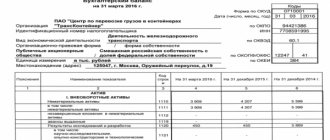Reflection of estimated liabilities in accounting is mandatory. Most often, accountants record a reserve for vacation pay. But this is not the only case where the obligations in question need to be taken into account. They are recorded only in reporting. The reserves will not appear on the tax return.
Question: How are the organization's estimated liabilities reflected in accounting and financial statements in connection with the emergence of employees' right to paid vacations in accordance with the legislation of the Russian Federation? According to the accounting policy of the organization, the formation of an estimated liability for payment of vacations to employees is carried out monthly on the last day of each month based on data on average earnings and the number of vacation days for each employee. Administrative expenses as semi-fixed expenses are recognized in the cost of sales in the period of their acceptance for accounting. In tax accounting, the organization does not create a reserve for upcoming vacation payments. View answer
What is an estimated liability?
Provisions are an existing obligation of an enterprise that has an uncertain amount or deadline. If available, a reserve must be created.
If the indicator does not appear in the reporting, this will lead to an overstatement of net profit. For this reason, financial statements will not provide objective information about the position of the enterprise. All this can lead to negative consequences: an increase in dividends and a deterioration in the financial condition of the organization.
Are provisions for doubtful debts classified as provisions?
Estimated liabilities differ significantly from other provisions. Let's look at examples:
- The company plans to repair equipment; this will require funds. A reserve of estimated liabilities will not be created for them, since repair work is not the responsibility of the organization. The company may change its mind about carrying out repairs.
- The reserve also does not need to be organized in the presence of ordinary obligations. The company ordered the goods. The products arrived, but the company did not pay for the contractor’s services. In this case, a reserve for estimated liabilities will not be created, since the existing debt is payable. It does not correspond to an important feature of an estimated liability - uncertainty of the amount and timing. In this example, the company knows how much money it owes and when it needs to be repaid.
- Estimated liabilities and estimated provisions differ. The latter represent an adjustment to the balance sheet indicators of assets associated with the receipt of new information. Valuation reserves are created in the presence of doubtful debts, a decrease in the value of inventories, and a decrease in prices for financial deposits. These indicators are not reflected in the balance sheet. The indicators under consideration will be recorded in the liability side of the balance sheet.
- Provisions that are created on the basis of undistributed earnings will also not be classified as provisions.
Difficulties often arise when fixing OO. To prevent errors, it is important to distinguish an estimated liability from other types of provisions.
Are estimated liabilities reflected in tax accounting ?
Document for calculating estimated liabilities and reserves in 1C ZUP 3
Starting from ZUP version 3.1.10, the document Accrual of estimated obligations for vacations has been renamed to the document Vacation reserves .
For more details, see Where can I find a document on the accrual of estimated obligations for vacations, starting with ZUP 3.1.10?
After installing the methodology for calculating estimated liabilities/reserves, Vacation reserves becomes available the Salary :
The Vacation Reserves document should be entered as the latest: after calculating wages for the month and generating the document Reflection of wages in accounting .
The Vacation Reserves document contains three tabs:
- Calculation of estimated liabilities for vacations - data on the basis of which the liabilities are calculated. The composition of this data is determined by the methodology selected in the organization’s settings;
- Estimated liabilities (by employees) - the results of calculating estimated liabilities by employees, departments and methods of reflection. Can be used to check totals;
- Estimated liabilities of the current month are total values broken down by departments and methods of reflection, which then go into the accounting program for generating transactions.
On the Calculation of estimated liabilities for vacations , the calculation is carried out separately for:
- estimated liabilities/reserves,
- contributions,
- contributions for “injuries”.
Moreover, each calculation group contains columns, the data for which is generated depending on the method used. Let's list these columns:
- Counted,
- Accumulated,
- Passed.
The emergence of estimated liabilities
Estimated liabilities may arise due to the following factors:
- Court decisions or agreements with relevant conditions. For example, a company enters into an agreement with its clients, according to which, if services are provided with insufficient quality, the money will be returned. Customers usually have complaints, so it makes sense to create a reserve. These will be estimated liabilities, since there is a high probability of their occurrence, but the exact amount is unknown.
- Actions that are not recorded in legal documents, but oblige the company to certain obligations. For example, a store posted an announcement that it would return money to customers if the purchased products turned out to be of poor quality. Despite the fact that this obligation is not formalized in any way, the store bears its consequences in connection with a public statement.
- A reserve has been formed for restructuring. It can be created only if the following conditions are met: there is a restructuring plan, interested parties are notified about the procedure.
- A deliberately unfavorable agreement was concluded. The company's managers are confident that they will suffer losses in connection with it. The LLC must be reflected in accounting in the same month in which the agreement is executed.
What are the features of inventory of estimated liabilities ?
Estimated liabilities are indicated in accounting only if the following conditions are met:
- Financial obligations cannot be avoided. For example, a company rents premises that, according to the lease agreement, need to be renovated. While repair work has not yet been carried out, it cannot be avoided.
- The probability of incurring expenses exceeds 50%.
- There is information that allows you to estimate the costs of fulfilling the obligation.
To form a reserve, all of the above conditions must be present. If one of them is not met, a contingent liability is recognized. This indicator does not need to be recorded. It is stated in the notes to the report.
Estimated liabilities in IFRS and RAS: recognition and measurement
Many companies are faced with the need to prepare several types of reporting: financial according to Russian accounting standards and international standards, management and tax. It is possible to optimize costs and reduce deadlines by bringing the accounting and reporting processes as close as possible.
Currently, a number of accounting provisions already comply with international standards, which does not require the use of special justifications for unifying accounting methods, but makes it possible at the level of accounting policies to bring the preparation of reporting under IFRS and RAS closer together. An example is IFRS 37 “Provisions, contingent liabilities and contingent assets”1 and PBU 8/2010 “Provisions, contingent liabilities and contingent assets”.
The purpose of these regulatory documents is to reflect in the reporting events that exist at the reporting date, but the negative or positive consequences of these events will affect the following reporting periods. This article will discuss the procedure for recognizing and assessing liabilities that arise as a result of these events.
The concept and place of estimated liabilities
The place of estimated liabilities in the totality of the organization's liabilities reflected in the statement of financial position is presented in Table 1.
| Financial | Non-financial |
| Accounts payable (or accruals payable) to suppliers and contractors. | Debt to staff. |
| Debt on loans and borrowings | Tax debt. Advances received. Deferred tax liabilities. |
| Other debt arising from contractual obligations | Estimated liabilities |
The separation of the category “Estimated liabilities” is due to the fact that such liabilities arise as a result of past events, while at the reporting date it is impossible to determine the exact amount of settlement of the liability and the deadline for fulfillment.
Example 1
The company that manufactures spare parts provides customers with a guarantee for the return of defective spare parts within 1 year from the date of sale. Based on past experience, customers return an average of 10% of spare parts sold within a year. Sales revenue in 2012 amounted to 5,000 thousand rubles. The amount of possible return obligations during 2013 may amount to 5,000 thousand rubles. x 10% = 500 thousand rubles.
As of December 31, 2012, the Company cannot estimate the actual amount of warranty obligations, as well as the exact time frame within which customers will contact us.
Estimated liabilities should be distinguished from the category of accruals of accounts payable under the contract.
Charges for utilities that have not yet been billed are reflected in accounts payable rather than in estimated liabilities because the amount of utility costs can be determined based on current tariffs and the repayment period is known.
FOR REFERENCE
In addition to warranty obligations for products, goods, work performed and services provided, the company may, for example, have the following types of estimated liabilities:
• estimated liabilities for claims brought against the company;
• obligations regarding disagreements with tax authorities regarding payment of payments to the budget that were not resolved as of the reporting date;
• obligations for environmental protection, environmental measures, land reclamation related to production activities and arising from the requirements of legislative and regulatory documents, contracts, actions or statements;
• estimated liabilities for obviously unprofitable contracts;
• obligations to decommission facilities, liquidation obligations for fixed assets and capital investments.
In Russian accounting practice, the accrual of obligations for vacation pay is carried out within the framework of PBU 8/2010, since the system of regulatory accounting regulations does not have special rules regarding the recognition of debts to employees in general and for vacation pay in particular2. According to international standards, these liabilities are accrued in accordance with IFRS 19 “Employee Benefits” and are disclosed under the item “Debt to Personnel” in the statement of financial position.
Recognition Criteria
IFRS 37 and PBU 8/2010 define the main criteria for recognizing an estimated liability, which must be met simultaneously: at the reporting date there is an obligation arising as a result of a past (obliging event); it is likely that an outflow of resources embodying economic benefits will be required to settle the obligation; the amount of the liability can be reliably estimated.
If these conditions are not met, the provision is not recognized in the statement of financial position.
Thus, when deciding on the existence of an estimated liability at the reporting date, it is necessary to carry out:
1. Assessing the presence of an obligating event.
2. Assessing the probability of resource outflow.
3. Assessing the possibility of reliably calculating the amount of the estimated liability.
Assessing the presence of an obligating event
At the reporting date, the company must analyze its activities to determine whether obligatory events exist3. Binding events arise not only from concluded contracts or legal requirements, but also as a result of the organization’s actions that create reasonable expectations among other parties to fulfill obligations or accept certain responsibilities (Table 2).
table 2
Occurrence of obligatory events
| Commitment | Sources | Examples of binding events |
| Legal | Treaties Legislation Court decisions | Delivery of products with a warranty provided for in the supply agreement. Availability of a license to operate an oil field, which provides for the need to restore the environment and dismantle fixed assets upon completion of operation. Suing the company |
| Voluntary | Established practice Published Policy Management Statement Actions that create a reasonable expectation among third parties that the organization will fulfill its obligations | For several years, the organization has provided customers with replacements for products that failed during the first year of operation with new similar products or carried out repairs at its own expense. These actions created a reasonable expectation among customers that if the purchased product failed, the organization would compensate them for the damage. |
The obligating event must be a past event. Events that result in an entity becoming aware of the costs that will need to be incurred to continue operations in the future are not binding. Thus, in particular, the costs of repair and maintenance, replacement of components of fixed assets are not recognized as estimated liabilities.
Example 2
The organization must replace components in the production line for technical reasons every 5 years. An obligation to replace components is not recognized at the reporting date because there is no obligation to replace components arising from past events. The costs of replacing components are allocated to future activities of the organization.
Assessing the likelihood of an outflow of resources containing economic benefits
The obligating event must result in an outflow of resources containing economic benefits, and the outflow of resources must be probable.
A reduction in the economic benefits of an entity necessary to satisfy an obligation is considered probable if it is more likely than not that such a reduction will occur.
Typically, an event is considered probable if the probability of resource outflow exceeds 50%.
Additionally, in addition to meeting the basic recognition criteria, the organization must ensure that there are no alternatives to settle obligations as a result of its future actions and the presence of negative consequences of avoiding obligations.
A provision is recognized on the balance sheet only if the obligation must be satisfied regardless of the future actions of the organization, including regardless of the future conduct of the company's business. In other words, the organization has no alternative but to fulfill its obligation by force of law (i.e., compulsion) or an event that creates reasonable expectations among others.
Example 3
The organization is required by law to carry out major repairs and technical inspection of operating equipment every 5 years. A liability is not recognized at the reporting date because the company can avoid compliance with legal requirements by selling the equipment.
Example 4
The company is implementing a line for the production of studded tires, and therefore it is planned to retrain some of the production personnel to work on this line.
Planned expenses for retraining are determined as of the reporting date.
However, a liability is not recognized because the company can avoid these costs by employing personnel with the necessary knowledge or by allowing personnel to obtain the necessary knowledge themselves.
The occurrence of significant negative consequences for the organization from evading the fulfillment of its obligation is another necessary condition for recognizing a provision. The consequences may be in the form of a claim against the company as a result of a trial, a fine, a penalty for terminating a loss-making contract, or a drop in the company’s reputation as a result of refusal to correct product defects under warranty.
Example 5
Under the contract, the plant must supply the buyer with cars worth 6,000 million rubles. however, as a result of rising prices for components, the sales price of the vehicles stipulated in the contract will amount to RUB 6,200 million. If the contract does not provide for significant penalties if the plant refuses to fulfill the contract, then there is no reason to recognize this liability in the statement of financial position.
Recognition in accounting and reporting
When recognizing an estimated liability, depending on its nature, the amount of the estimated liability:
• attributed to expenses (operating or other for RAS);
• included in the cost of the asset.
It should be noted that IFRS 37 and PBU 8/2010 do not clearly indicate the procedure for recognizing one or another type of estimated liability as an asset or expense. To do this, it is proposed to be guided by other standards (provisions) for accounting and reporting.
In general, all provisions are recognized as expenses. However, IFRS 16 Property, Plant and Equipment requires that the original cost of a property, plant and equipment be determined by taking into account the costs of dismantling, removing the item and restoring natural resources on the site. Therefore, when recognizing an obligation to liquidate a fixed asset, its amount is included in the cost of the asset and is depreciated over the life of the asset.
The current PBU 6/01 “Accounting for fixed assets” does not provide for a direct rule on including in the initial cost of fixed assets the costs of dismantling, removing an object and restoring natural resources. However, this does not mean that these expenses cannot be included in the initial cost of a fixed asset. To justify this approach, you can use clause 8 of PBU 8/20104.
Initial assessment of provisions
As a general rule, an estimated liability is recognized in the organization's records in an amount that reflects the most reliable estimate of the costs required at the end of the reporting period to fulfill (terminate) the obligation or transfer it to a third party.
The estimate of the liability is based on management's judgment, historical statistics on similar situations, expert opinions and other information. Thus, the procedure for determining the amount of the estimated liability may be individual for each organization and depend on the specifics of its activities.
The estimated cost required to settle the obligation is the reasonable amount that the organization will pay at the end of the reporting period for the fulfillment (termination) of the obligation or its transfer to a third party. This takes into account the costs not only of fulfilling the obligation itself, but also of termination (fines, penalties) or transfer (re-registration of documents).
The norms of PBU 8/2010 and IFRS 37 provide different ways to determine the estimated cost.
If the reserve is determined in relation to a set of objects, then the “expected value” is used. Expected value is the weighted average of all possible outcomes by the probability of each outcome occurring.
Example 6
The company sells products with a guarantee. According to the terms of the contract, it will eliminate any manufacturing defect or replace goods that cannot be repaired within 1 year from the date of purchase. The cost of replacing all products sold is 500 thousand rubles. The costs of repairing all goods sold are 100,000 thousand rubles. Based on the company's past experience, 70% of goods sold as of the reporting date will not be defective, 20% of goods will require repair, and 10% will need to be replaced.
The expected cost of the costs of eliminating defects, and therefore the amount of the estimated liability, will be 100,000 x 20% + 500,000 x 10% = 70,000 thousand rubles.
If the reserve is determined in relation to a single object, then the estimated cost will be the value of the most probable outcome
Example 7
The company was sued in the amount of 7,000 thousand rubles. The probability that, following the results of the trial, she will pay the claim in full is 70%; the probability that the company will win the case is 30%.
The cost of fulfilling the legal obligation is estimated at 7,000 thousand rubles, since there is a high probability that the company will lose the trial.
In this case, when determining the amount of litigation, it is inappropriate to calculate the weighted average cost of possible expenses.
Example 8
The company is facing a lawsuit in the amount of 7,000 thousand rubles, which includes payment of the principal amount of debt of 4,000 thousand rubles. rub. and penalties in the amount of 3,000 thousand rubles. The company estimates that it will lose the trial. There is an 80% chance that she will only pay off the amount owed. However, with a 20% probability, it is possible that the principal amount of the debt will have to be paid a penalty in the amount of 2,000 thousand rubles.
The cost of fulfilling a legal obligation is estimated in this case at 4,400 thousand rubles. (4,000 x80% + 2,000) x20%).
Obligations under onerous contracts are assessed at the lesser of the costs required to perform or terminate the contract.
Example 9
Let's use the data from example 5. Under the contract, the plant must supply the buyer with cars worth 6,000 million rubles. However, as a result of rising prices for components, the sales price of the cars stipulated in the contract will amount to 6,200 million rubles. For termination of the contract, the plant is obliged to pay a penalty in the amount of 100 million rubles.
The estimated liability is recognized in the amount of RUB 100 million. (the least of the costs of executing the contract is 6,200 – 6,000 – 200 million rubles and the amount of refusal to perform the contract is 100 million rubles).
The amount of the provision upon recognition should be determined taking into account changes in the value of money over time. If the repayment or transfer of the obligation exceeds 12 months from the occurrence of the obligating event, then the cash outflows of resources are discounted.
An increase in the amount of an estimated liability due to an increase in its produced value on subsequent reporting dates as the deadline approaches (interest) is recognized as part of the organization’s financing costs.
Example 10
The company erected a warehouse building on a plot of land leased from the city. According to the terms of the lease agreement, the land lease period is 8 years. After the end of this period, the company is obliged to dismantle the warehouse and restore the land. The costs of dismantling the warehouse building are estimated at 2,200 thousand rubles. at the time of completion of construction (December 31, 2012).
The discount rate is 7%.
Discounted cash flow is calculated using the formula
DCF = Net cash flow x 1 / (1 + r)n,
where r is the discount rate;
n—discounting period.
The estimated liability for dismantling the warehouse and restoring the land plot as of December 31, 2012 is equal to RUB 2,200 thousand. / (1 + 0.07)8 = 1,280 thousand rubles.
The statement of financial position of the company as of December 31, 2012 will reflect an estimated liability for the dismantling of fixed assets and restoration of a plot of land as part of long-term liabilities in the amount of RUB 1,280 thousand. and at the same time the item “Fixed assets” was increased by this amount.
Dt general physical training program “Fixed assets”
Kt OFP “Estimated liability for dismantling fixed assets” - 1,280 thousand rubles.
Estimated dismantling liability and its effect on the financial statements as at 31 December 2013.
Discounted amount of the provision
will amount to 2,200 thousand rubles. / (1 + 0.07)7 = 1,370 thousand rubles.
Change in estimated liability for 2013
will be 1370-1 280 = 90 thousand rubles.
The company will make an entry for the amount of the change in the reserve amount
Dt general financial statement “Interest expenses”
Kt OFP “Estimated liability for dismantling fixed assets” - 90 thousand rubles.
Subsequent assessment of liabilities
Provisions are reviewed at the end of each reporting period and adjusted to reflect the best estimate of the costs required at the end of the reporting period to settle the liability.
Obligations are reviewed for changes:
• in the expected outflows of the organization's resources (change in the amount required to repay the obligation);
• discount factor.
Adjustments to the estimated liability can either be made at the expense of the organization’s expenses or be included in the value of assets if, upon initial recognition, the amount of the estimated liability was previously included in the value of the asset (Table 3).
Table 3
| Change in provision | Procedure for recognizing changes | Example |
| Discount factor related | Interest income/expense | Changing the discount rate. Changing the discount period. |
| Related to changes in expected outflows | Interest income/expense The book value of the asset. | Changing the method/technology of dismantling, environmental restoration. Changes in prices for restoration work. |
Thus, it is advisable for companies to develop and approve in their accounting policies a unified methodology for the recognition and assessment of estimated liabilities for the purposes of IFRS and RAS, taking into account that regulations in the field of international standards and Russian accounting allow this to be done with minimal costs.
1 IFRS 37 applies the definition of “provisions” to provisions. For the purposes of this article, it is proposed to use only the term “estimated liability”.
2 The draft PBU “Accounting for Employee Remuneration” is presented on the website of the Ministry of Finance of the Russian Federation, so this difference will actually be eliminated.
3 PBU 8/2010 does not contain the concept of “obliging event”, however, clause 6 contains provisions on the occurrence of obligations that fully comply with the norms of IFRS 37.
4 The new draft PBU 6 “Accounting for fixed assets” has added a direct rule on including the costs of dismantling and removing an object into the initial cost of fixed assets.
Accounting for estimated liabilities
Estimated liabilities are recorded on account 96 “Reserves for future expenses”. The amount may be reflected both in the list of specific expenses (for example, expenses for repairs under warranty) and in the list of other expenses.
OO accrual transactions will look like this:
- DT 20 (23, 25, 26, 44) CT 96 “Reserves for future expenses”
Repayment of obligations will be reflected as follows:
- DT 96 “Reserves for future expenses” CT 10, 76, 70, 90
The selected accounts are determined by the transaction performed.
Example
The company is involved in litigation. It is expected that he will have to pay 80,000 rubles. This will be reflected as follows:
- DT 76 “Settlements with various debtors and creditors” CT 96 “Reserves for future expenses”
A court decision has been received. The company's calculations did not come true. The organization will need to pay 100,000 rubles. The operation can be reflected as follows:
- Repayment of OO: DT 96 “Reserves for future expenses” CT 76 “Settlements with creditors”, subaccount “Settlements for claims”. The transaction amount is indicated: 20,000 rubles.
- Amount that needs to be paid additionally: DT 91 “Other income and expenses”, subaccount “Other expenses” KT 76, subaccount “Calculations for claims”. The amount that needs to be paid is indicated: 20,000 rubles.
All specified transactions must be confirmed by primary documentation. From the accounting it is possible to clearly understand which transactions were carried out.
Is it necessary to reflect estimated liabilities in tax accounting?
Lack of information about a PA in tax accounting is not an error. You do not have to indicate reserves, as they do not affect the amount of taxes assessed. This information will not be required by the tax authorities. But it will be useful to banking institutions to which the enterprise applies, or to its investors.
Summary
Estimated liabilities require the creation of a reserve. In order for obligations to be recognized as valuation obligations, they must meet a number of conditions. The main signs are the inability to determine the exact amounts of accruals and the timing of their repayment. Commitments must be inevitable. For example, they appear on the basis of agreements with employees. If the obligation does not meet the established requirements, then it is taken into account in a different manner. OO are recorded only in accounting. There is no need to indicate them in the tax return, since the estimated expenses do not affect the amount of taxes. Their appearance in accounting is mandatory.











